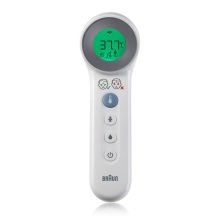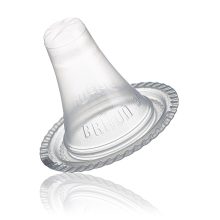Temperature readings vary from one healthy person to another and are influenced by factors such as age, gender, and ambient temperature. Temperature readings vary even in the same person at different times. Therefore, normal body temperatures can only be given as ranges.
Readings from different parts of the body also differ from each other. For example, rectal temperatures tend to be higher than oral (mouth) temperatures, and ear and armpit temperatures tend to be lower than oral temperatures. Here are ranges of average temperatures of healthy people taken from different body sites in various studies (Sund-Levander et al 2004):
Mouth 33.2°C to 38.2°C
Armpit 35.5°C to 37.0°C
Rectal 34.4°C–37.8°C.
Because of the wide variation in “normal” temperatures, Age Smart instructions suggest that you find out your normal temperature ranges by taking your temperature several times when you are feeling healthy. Guidelines issued by NICE (National Institute for Health and Clinical Excellence) suggest that fever should be defined as “an elevation of body temperature above the normal daily variation” (NICE 2007).
National Institute for Health and Clinical Excellence (NICE). National Collaborating Centre for Women’s and Children’s Health. Feverish illness in children. Ed. Welsh A. RCOG Press at the Royal College of Obstetricians and Gynaecologists. 2007. http://guidance.nice.org.uk/CG160
Sund-Levander M, Grodzinsky E, Loyd D, Wahren LK. Errors in body temperature assessment related to individual variation, measuring technique and equipment. Int J Nurs Pract. 2004;10(5):216-23.
The differences are small, and many healthy children have temperatures similar to temperatures in adults and vice versa.
One large study found that, on average, body temperature gets lower as people get older (Chamberlain et al 1995), but other studies do not agree (Herzog & Coyne 1993, Stern et al 2009). So the assumption that children in general have higher normal body temperatures than adults may not be true.
Chamberlain JM, Terndrup TE, Alexander DT, et al. Determination of normal ear temperature with an infrared emission detection thermometer. Ann Emerg Med. 1995;25(1):15-20.
Herzog LW, Coyne LJ. What is fever? Normal temperature in infants less than 3 months old. Clin Pediatr (Phila). 1993;32(3):142-6.
Stern G, Beel J, Suki B, et al. Long-range correlations in rectal temperature fluctuations of healthy infants during maturation. PLoS One. 2009;4(7):e6431.
The tops of “normal” temperature ranges, which are based on statistical sampling of healthy people, are not the same as fever as defined by medical criteria. The Age Smart color scale is not meant to show whether temperatures are within the normal range. It is intended to alert users to temperatures that they should worry about based on the most conservative criteria. Very young babies may not run high fevers when they have infections, so even a temperature that is only a little higher than normal may be a sign of infection in a little baby. In little babies, even a small rise in temperature must be taken seriously (Jain et al 2014).
You should also keep in mind that fever is only one of the clinical signs of serious illness. Doctors decide whether to treat a patient with fever based on such things as how long the patient has had a fever, whether the patient has had all the important shots (immunizations), whether the patient seems unusually sleepy, whether the patient has a rash, and whether the patient has been vomiting or has no appetite.
Jain S, Cheng J, Alpern ER, et al. Management of febrile neonates in US pediatric emergency departments. Pediatrics. 2014;133(2):187-95.
High fever in children should be a concern. Consult a physician if a child’s temperature is in the elevated (fever) or high temperature (high fever) range, especially if the child has symptoms along with fever.
High fever usually is a sign of infection, which can be either viral or bacterial. In young children, there is a chance that the infection can be meningitis or sepsis, either of which can be very serious. To be on the safe side, if temperature readings are elevated or high, you should consult a doctor immediately. The doctor will ask about symptoms, because without symptoms, even a high temperature may not be cause for alarm.
You may choose to not consult a doctor if the indicator is green and is not accompanied by worrisome signs or symptoms. If you have doubts about the symptoms, you should always consult your physician.
The cutoff of 37.7 is specific to the Thermoscan Infrared Ear thermometer only. Different digital thermometers are programmed to give different readouts from different body sites. Since the Thermoscan Infrared Ear thermometer displays an oral equivalent display reading, the cutoff has been set to a value that would be considered an elevated temperature on an oral thermometer.. For a different thermometer that has been set to display a rectal or underarm reading, the threshold would be different. For a thermometer set to display a rectal temperature equivalent, for example, a reading of 37.7°C on an oral equivalent thermometer would be equivalent to 38°C rectally and the yellow indicator light would be triggered at this temperature.
The standard definitions of fever used in emergency departments generally start at about 38 C (Sullivan 2011, Am Coll Emergency Physicians 2003, NICE 2007, Hoffman et al 2013). Keep in mind that temperature above 38 C is only one of the factors that doctors consider when deciding whether to run diagnostic tests or admit a patient to the hospital. Doctors consider symptoms as well as temperature readings and laboratory tests to decide whether treatment is needed.
American College of Emergency Physicians Clinical Policies Committee; American College of Emergency Physicians Clinical Policies Subcommittee on Pediatric Fever. Clinical policy for children younger than three years presenting to the emergency department with fever. Ann Emerg Med. 2003 Oct;42(4):530-45.
Hoffman RJ, Etwaru K, Dreisinger N, Khokhar A, Husk G. Comparison of temporal artery thermometry and rectal thermometry in febrile pediatric emergency department patients. Pediatr Emerg Care. 2013;29(3):301-4.
National Institute for Health and Clinical Excellence (NICE). National Collaborating Centre for Women’s and Children’s Health. Feverish illness in children. Ed. Welsh A. RCOG Press at the Royal College of Obstetricians and Gynaecologists. 2007. http://guidance.nice.org.uk/CG160
Sullivan JE, Farrar HC, Section on Clinical Pharmacology and Therapeutics, Committee on Drugs. Fever and antipyretic use in children. Pediatrics. 2011;127(3):580-7.
For children in the age range of 0 to 3 months, temperatures above 38 C (rectal) often mean that there is an infection, so they need immediate attention. In very young babies, any temperature elevation should be considered serious (red zone). That is why no yellow zone is given for this age group on the Age Smart scale.
NICE guidelines (NICE 2007) suggest that the cutoff for high fever should be 38.0°C (rectal) for infants less than 3 months of age and 39°C (rectal) for infants between 3 and 6 months of age. When adjusted to an equivalent value for oral readings, these are the same as the Age Smart cutoffs for high fever that are programmed into the Thermoscan Infrared thermometer.
However, the Age Smart scale adds an intermediate elevated temperature range for toddlers between 3 and 36 months to be more conservative, since you would not want to miss a potentially dangerous illness.
National Institute for Health and Clinical Excellence (NICE). National Collaborating Centre for Women’s and Children’s Health. Feverish illness in children. Ed. Welsh A. RCOG Press at the Royal College of Obstetricians and Gynaecologists. 2007. http://guidance.nice.org.uk/CG160
If there are symptoms, such as unusual irritability, unresponsiveness, weakness, vomiting, diarrhea, dry skin, unusual thirst, seizure, loss of appetite, or changes in activity, you should contact a doctor regardless of whether the thermometer shows green, yellow, or red.
If temperature readings are in the red range, you should speak with a doctor whether or not there are symptoms . Someone who has an elevated temperature in the yellow range and also feels sick (or appears to be sick), should speak with a doctor to find out whether to come into the medical office. You may choose not to consult a physician only if the indicator is green and there are no symptoms. When in doubt about symptoms, always consult your physician.
A fever is a body temperature higher than normal condition. There will be symptoms found: tiredness, muscle ache and headache. However definition of fever temperature is dependent on the following two aspects:
1. Age
According to clinical research in the United States, the definition of fever varies with newborn babies, children and adults. In other words, the definition of fever changes with the babies of age groups 0 to 3 months, 3 to 36 months & over 36 months.
2. Way of temperature measurement
There are two kinds of temperature when it comes to human body temperature: internal body temperature & body surface temperature, each associated with different ways of measurement: oral, inner ear, forehead, anus and underarm. And the reading produced by each different way of measurement may vary. Among the different measurement methods internal body measurement is most accurate, because all other kinds of body surface measurement can be affected through the environment of measurement.
Basically the answer is positive, except for the cases of reaction to vaccine injection, or dehydration due to: extensive outdoor activities, or heat stroke, heat exhaustion under hot weather. To the contrary, however sickness does not necessarily cause a fever. Therefore it is advisable for the parents to consult the physician before a diagnosis is made.
Generally it falls between September & October, but with possible early, delay or extended occurrence. The symptoms mostly include fever, tiredness, muscle ache, headache, etc…
All infectious deceases such as bacterial, filterable viruses may cause a fever.
Yes. Because they are unlikely subject to virus infection. In the case of a fever on a new born, it is advisable that the parents should be cautious and consult a doctor.
1. Fever following vaccine infection:
Dose of infant antipyretic should be adequate. In case the fever persists for over 48 hours, revisit of doctor is necessary.
2. Fever due to respiratory tract infection:
Use warm bath to bring down the fever, medication to control the situation. The fever might not be brought down within 1-2 days. Revisit of the doctor is necessary if fever is not brought down in 3 days. Look closely for any new symptoms aroused. Be cautious of other internal infections like neural system, and muscle etc…
3. Urethritis:
Close monitor with dose of anti-biotics is necessary. Follow up with urine inoculum report, and variations in fever temperature which reflect efficacy of the treatment.
Dependent on the situation, in general, ear measurement gives a better accuracy while forehead measurement is handier and more suitable for babies’ uses during daytime or asleep. But forehead measurement is easily subject to be affected by respiration and air-conditioning in the environment. So 30 minutes of stay in a stable environment is necessary to get an accurate reading. In case a deviation in reading from forehead measurement is found, it is advisable to use an infrared ear thermometer to guarantee a good accuracy.
Fever is not a disease by itself but a symptom of a disease. It implies the fact that the body is being attacked by virus or bacteria, or a breakdown of a certain mechanism.
It is most important for the parents to bring the child to see a doctor as soon as a fever is detected. A fever is only a symptom of a problem in the body. Only under doctor’s diagnosis of the cause can bring proper treatment to the problem. The parents should also take temperature of the child regularly to monitor and see if body temperature is under control.
![]()
Dependent on the situation, the parents should make close monitor on the child if he’s in high fever. A temperature measurement in every 1-2 hours is recommended. If the fever persists after medication, revisit to doctor is needed. For a mid level fever, a temperature measurement for every 3-4 hours is good enough.
The parents may:
- Give warm water bath to help bring down the temperature. Be sure not to give cold nor hot water bath.
- Provide more water in-take just to prevent dehydration.
- Provide cooling paste on the forehead, rear neck or undearm to help bring down the fever.
Oral and anal measurements are more accurate than other ways. However, children under 2 years of age are not suitable for oral measurement. And anal measurement may cause pain to the children that worries the parents. So inner ear and forehead formats are more popular options which fit in different situations.
It is advisable for the parents to use inner ear format, because inner ear measurement can access to the temperature of the central trunk of the body, free of any factors that affects the temperature reading, which serves better temperature measurement accuracy than other parts of the body.
But forehead format provides convenience in using. Only a few seconds of the thermometer pointed to the forehead may do the job. Some new forehead format thermometers do not require any physical touch of forehead, nor any horizontal scanning. They are free of any disturbance on the sick children, are suitable for uses when the children are asleep or daily use prior to going to school.
Most parents are not aware of the importance of using a new probe cover in each measurement. Using a new probe cover may:
- gurantee hygiene on the probe cover
- avoid damage on the cover which can hurt inner ear canal
- Cross-contamination
Some children in fever may be contracted with otitis media. Re-uses of cover may allow bacteria to develop on the cover surface, which facilitates cross infection of virus and bacteria, spreading the infection to other members of the family.
Children is more susceptible to virus infection because of their body resistance is not as strong as a grown up. So having a thermometer at home is very important to monitor temperature to safeguard the health of them.
Also most schools require the kids to take temperature at home prior to going back to school, just to ensure they are free of fever.
When Tonnie first became a mother, she did not know how to select a thermometer. Then she saw that Braun infrared ear thermometers are popular among the healthcare professionals in the hospital. And her peer mother friends mostly use Braun thermometers. With the quality and reliability that comes with, Tonnie has selected Braun.
Tonnie has a 2 year-old & a 4 year-old boys. She thinks both infrared ear & forehead modes have their advantages. In her experience, she used mostly infrared ear when her boys were small because it will not be affected by external factors, so a higher accuracy can be expected. But when her boys grew up to go to school, she started to use a forehead theremometer to do daily temperature check before school. Both kinds of thermometers serve in different situations.





